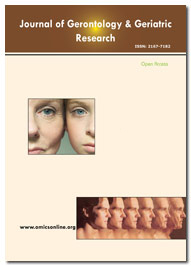Indexed In
- Open J Gate
- Genamics JournalSeek
- SafetyLit
- RefSeek
- Hamdard University
- EBSCO A-Z
- OCLC- WorldCat
- Publons
- Geneva Foundation for Medical Education and Research
- Euro Pub
- Google Scholar
Useful Links
Share This Page
Journal Flyer

Open Access Journals
- Agri and Aquaculture
- Biochemistry
- Bioinformatics & Systems Biology
- Business & Management
- Chemistry
- Clinical Sciences
- Engineering
- Food & Nutrition
- General Science
- Genetics & Molecular Biology
- Immunology & Microbiology
- Medical Sciences
- Neuroscience & Psychology
- Nursing & Health Care
- Pharmaceutical Sciences
Perspective - (2024) Volume 13, Issue 4
Aging in Place: Strategies for Enhancing Home-Based Care and Community Support Systems for Seniors
Brook De Fleixo*Received: 03-Aug-2024, Manuscript No. jggr-24-27611; Editor assigned: 05-Aug-2024, Pre QC No. P-27611; Reviewed: 17-Aug-2024, QC No. Q-27611; Revised: 23-Aug-2024, Manuscript No. R-27611; Published: 30-Aug-2024, DOI: 10.35248/2167-7182.2024.13.744
Introduction
As the global population ages, the concept of "aging in place" has become a cornerstone in the conversation around senior care. Aging in place refers to the ability of older adults to remain in their homes and communities as they age, rather than relocating to institutionalized care settings. This approach offers numerous benefits, such as promoting independence, maintaining a sense of control over one’s environment, and supporting emotional well-being. However, aging in place also presents a set of challenges, including the need for accessible home modifications, supportive community services, and coordinated healthcare systems. This article will explore strategies for enhancing home-based care and community support systems that empower seniors to age in place successfully [1].
The desire to age in place has gained significant attention in recent years, driven by the growing preference among older adults to remain in familiar environments rather than transitioning to institutionalized care settings. Aging in place not only aligns with the natural human desire for autonomy and control, but it also supports mental and emotional health by reducing the stress and isolation that can often accompany relocation. With advancements in healthcare and technology, the traditional notion that aging necessarily involves moving to a nursing home or assisted living facility is increasingly being challenged [2]. Today, many older adults are seeking innovative ways to stay in their homes for as long as possible, leading to the need for effective strategies that integrate home-based care with community support systems. However, the ability to age in place is not universally accessible. For some seniors, the lack of financial resources, limited access to healthcare, and inadequate housing options can present significant barriers to maintaining independence at home. Additionally, the strain on healthcare systems and the growing demand for senior care further complicate the issue. Therefore, creating a sustainable framework for aging in place requires a comprehensive approach—one that combines home modifications, technology, social support, and healthcare innovations to address these challenges. This article will explore how these diverse strategies can work together to create an environment where seniors can live safely, comfortably, and independently in their own homes and communities [3].
Description
Another important strategy for enhancing aging in place is the development of caregiver support programs. Many seniors rely on family members or informal caregivers to assist with daily activities, medication management, and transportation. However, caregiving can be physically, emotionally, and financially taxing on family members, leading to burnout and strained relationships. To address this, support services for caregivers are crucial. These programs can provide respite care, training, counseling, and resources to help caregivers manage their responsibilities more effectively [4]. By supporting caregivers, we not only improve the quality of care that seniors receive but also ensure that families can continue to be a key part of the aging-in-place process without facing overwhelming stress. Additionally, promoting a culture of inclusion and age-friendly environments is vital for creating communities that support seniors’ well-being. Age-friendly communities are those that prioritize the needs of older adults through accessible public spaces, affordable housing, and a range of services designed to accommodate an aging population. This might include pedestrian-friendly streets, accessible public transportation, and opportunities for lifelong learning and social engagement [5]. These communities not only benefit seniors but also foster intergenerational connections, where older adults are integrated into the fabric of community life. Encouraging municipalities to adopt policies and urban planning strategies that reflect the needs of aging populations ensures that seniors can stay active, engaged, and connected within their communities as they age in place.
Addressing the challenges of aging in place requires a shift in how society views aging and older adults. Rather than focusing solely on the physical limitations that come with age, we must emphasize the vast potential and experience that older individuals bring to communities. Creating a more inclusive society, where seniors are valued as active participants, not just recipients of care, can foster a sense of purpose and belonging. This cultural shift can help reduce the stigma often associated with aging and encourage seniors to remain engaged in work, volunteerism, and social activities, all of which contribute to their overall well-being.
Conclusion
The development of innovative technologies and data-driven solutions holds great promise for enhancing aging in place. From wearable health devices that monitor vital signs to artificial intelligence that can predict health risks and personalize care plans, technology offers unprecedented opportunities to support seniors in maintaining their independence. As these technologies become more accessible and integrated into home care systems, they can significantly improve the efficiency and effectiveness of aging-in-place strategies. By continuing to invest in research and development, we can create smarter homes, safer environments, and more personalized care solutions that empower seniors to age comfortably and securely in their own homes for as long as possible.
Acknowledgement
None.
Conflict of Interest
None.
References
- Svenson O, Fischhoff B, MacGregor D. Perceived driving safety and seatbelt usage. Accid Anal Prev. 1985;17:119-133.
- Filippini M, Masiero G, Santarossa M. Productivity change and efficiency in the Swiss nursing home industry. Appl Econ. 2022;54:2837-2850.
- Fuino M, Ugarte Montero A, Wagner J. On the drivers of potential customers' interest in long‐term care insurance: Evidence from Switzerland. Risk Manag Insur Rev. 2022;25:271-302.
- Furfaro E, Pelle E, Rivellini G, Zaccarin S. Which support is provided in which country? Patterns among older adults in Europe. Euro J Ageing. 2024;21:15.
- Gentili E, Masiero G, Mazzonna F. The role of culture in long-term care. 2016.
Google Scholar, Crossref, Indexed at
Google Scholar, Crossref, Indexed at
Google Scholar, Crossref, Indexed at
Google Scholar, Crossref, Indexed at
Citation: Fleixo BD (2024). Aging in Place: Strategies for Enhancing Home-Based Care and Community Support Systems for Seniors. J Gerontol Geriatr Res. 13: 744.
Copyright: © 2024 Fleixo BD. This is an open-access article distributed under the terms of the Creative Commons Attribution License, which permits unrestricted use, distribution, and reproduction in any medium, provided the original author and source are credited.

